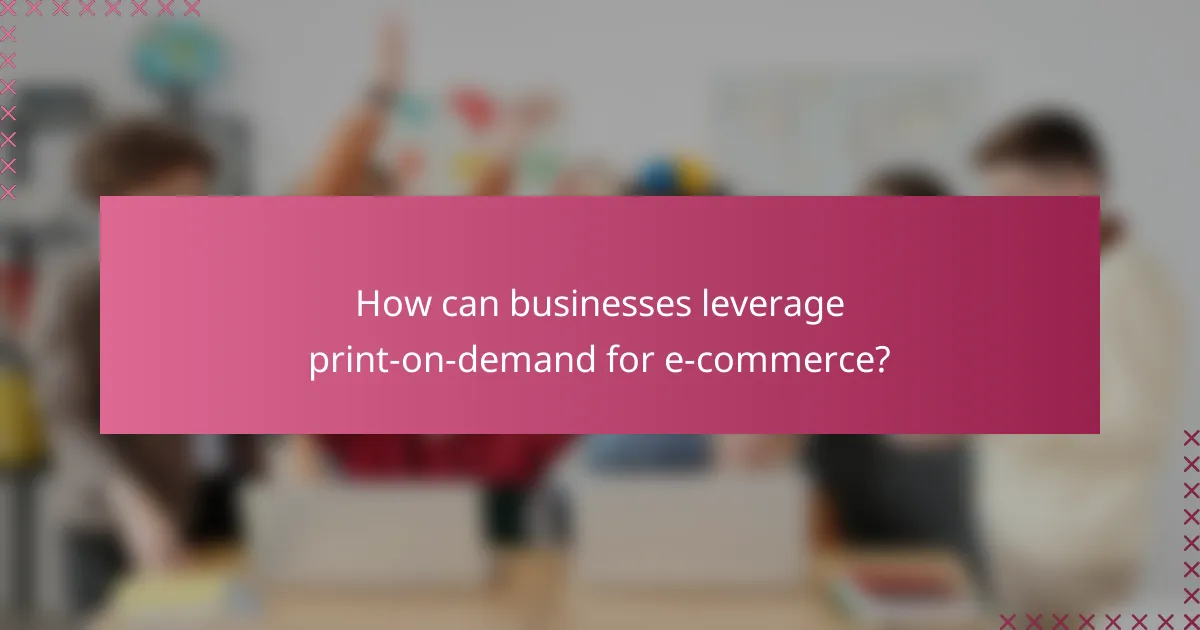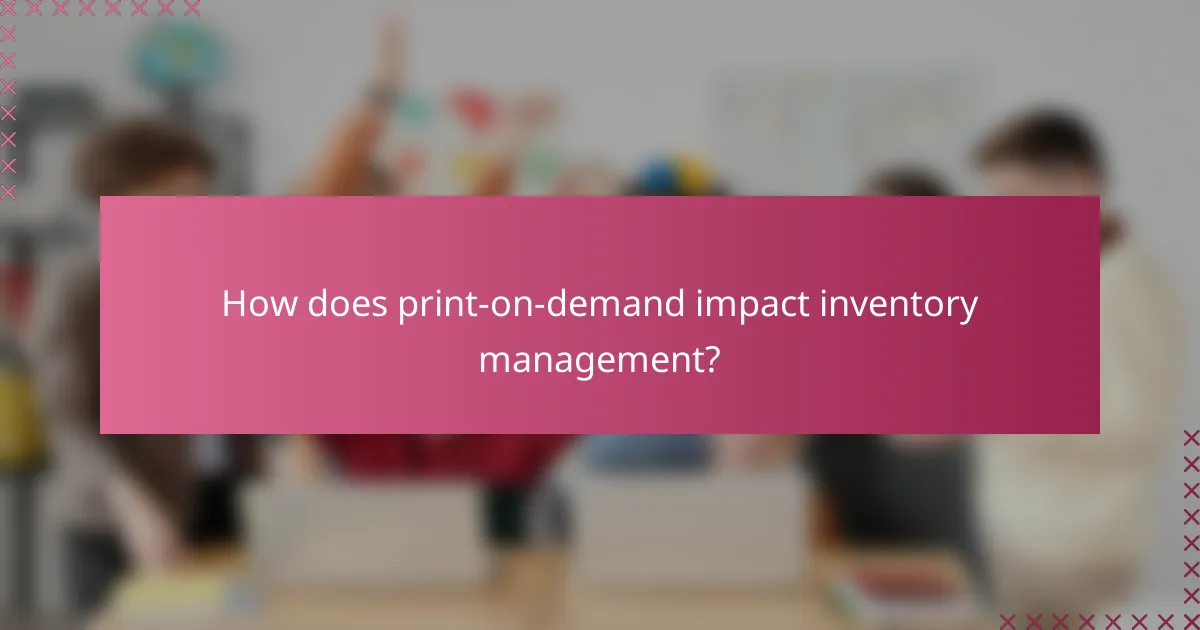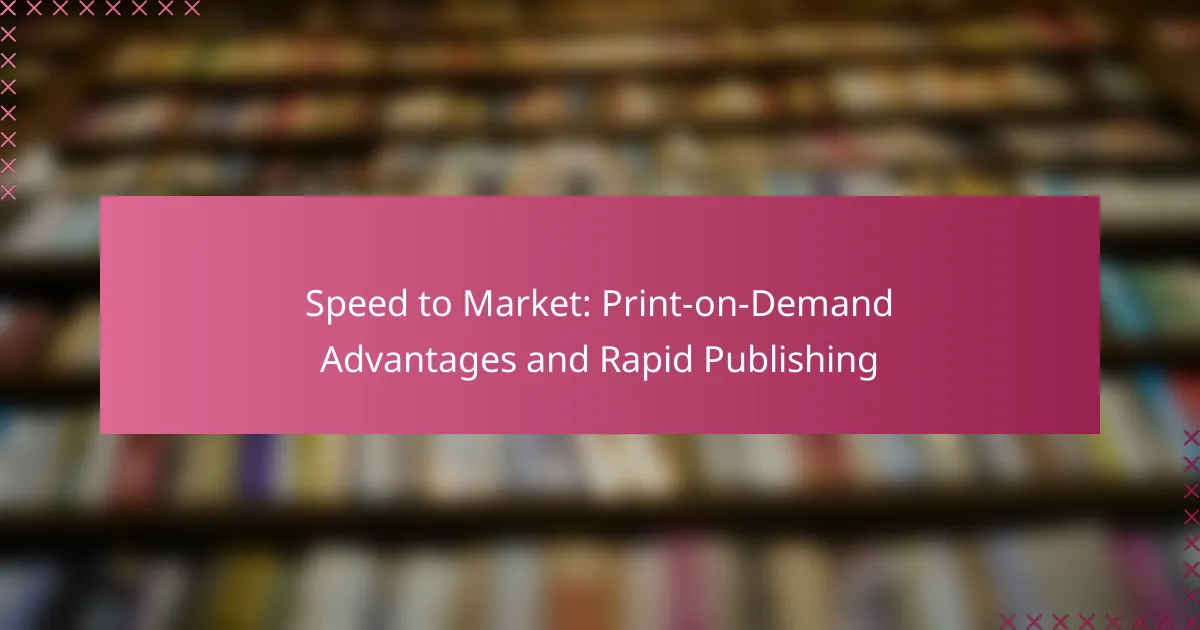Print-on-demand (POD) revolutionizes the publishing landscape by enabling creators to produce items only as they are ordered, significantly reducing the time to market. This model not only eliminates the need for large upfront inventory investments but also allows businesses to swiftly adapt to consumer demand. With advantages like customization, reduced financial risk, and scalability, POD is an appealing choice for both new entrepreneurs and established companies aiming to streamline their operations.

How does print-on-demand accelerate speed to market?
Print-on-demand significantly speeds up the time it takes to bring products to market by allowing creators to produce items only as they are ordered. This model eliminates the need for large upfront investments in inventory, enabling businesses to respond quickly to consumer demand.
Eliminates inventory costs
Print-on-demand removes the burden of maintaining inventory, which can be costly and risky. Businesses no longer need to invest in bulk printing or storage, reducing overhead expenses and minimizing waste. This approach allows for a more flexible financial model, especially beneficial for startups and small businesses.
For example, a small publisher can produce books only when they receive orders, avoiding the costs associated with printing thousands of copies that may not sell. This not only conserves cash flow but also allows for a more dynamic response to market trends.
Facilitates rapid product launches
With print-on-demand, businesses can launch new products quickly without the delays associated with traditional printing methods. Once a design is finalized, it can be made available for purchase almost immediately, allowing for faster entry into the market.
This speed is crucial in competitive industries where trends can change rapidly. For instance, a fashion designer can create a limited edition clothing line and have it available for sale within days, rather than weeks or months.
Enables real-time market testing
Print-on-demand allows companies to test new products in the market without significant financial risk. By offering a limited run of a product, businesses can gauge consumer interest and gather feedback before committing to larger production runs.
This approach is particularly useful for entrepreneurs looking to validate their ideas. For instance, an artist can release a series of prints and analyze sales data to determine which designs resonate most with customers, informing future offerings.

What are the key advantages of print-on-demand?
Print-on-demand offers several key advantages, including customization, reduced financial risk, and scalability. These benefits make it an attractive option for both consumers and businesses looking to streamline their publishing processes.
Customization options for consumers
Print-on-demand allows consumers to personalize products, such as books or apparel, to fit their unique preferences. This customization can range from choosing cover designs to selecting specific text or images.
For example, a customer might order a book with a custom cover featuring their name, making it a perfect gift. This level of personalization enhances customer satisfaction and can lead to increased sales.
Reduced financial risk for businesses
Businesses utilizing print-on-demand can significantly lower their financial risk by eliminating the need for large upfront inventory purchases. Instead of printing thousands of copies, companies can print items as orders come in.
This model minimizes storage costs and reduces the likelihood of unsold stock. It allows businesses to test new products with minimal investment, making it easier to pivot based on market demand.
Scalability for growing brands
Print-on-demand provides a scalable solution for brands looking to expand their product offerings without the constraints of traditional printing methods. As demand increases, businesses can easily increase their output without the need for additional infrastructure.
This flexibility is particularly beneficial for startups and small businesses that may not have the resources for large-scale production. By leveraging print-on-demand, they can grow their brand while maintaining control over production costs and timelines.

How can businesses leverage print-on-demand for e-commerce?
Businesses can leverage print-on-demand (POD) for e-commerce by offering customized products without the need for inventory. This model allows for quick product launches and reduced financial risk, making it ideal for entrepreneurs and established businesses alike.
Integration with Shopify
Integrating print-on-demand services with Shopify is straightforward and enhances the e-commerce experience. Shopify’s platform allows businesses to connect with various POD providers seamlessly, enabling automatic order fulfillment and inventory management.
To set up, choose a POD app from the Shopify App Store, install it, and link your products. This integration can lead to faster time-to-market as products can be listed and sold almost immediately after design.
Utilization of Printful services
Printful is a popular print-on-demand service that offers a wide range of customizable products, from apparel to home decor. Businesses can create unique designs and have them printed and shipped directly to customers, minimizing overhead costs.
Utilizing Printful’s services involves creating an account, uploading designs, and selecting products to sell. Their user-friendly interface and reliable shipping options make it a preferred choice for many e-commerce entrepreneurs.
Partnerships with local printers
Forming partnerships with local printers can provide businesses with faster turnaround times and potentially lower shipping costs. Local printers often have the capability to produce high-quality products quickly, which is essential for meeting customer demands.
When considering local partnerships, evaluate their production capabilities, pricing structures, and delivery times. This approach not only supports local economies but can also enhance customer satisfaction through quicker delivery and personalized service.

What criteria should be considered when choosing a print-on-demand provider?
When selecting a print-on-demand provider, focus on product quality, shipping efficiency, and customer service. These factors significantly impact your overall experience and the satisfaction of your customers.
Product quality and variety
Product quality is crucial as it directly affects customer satisfaction and brand reputation. Look for providers that offer high-quality materials and printing techniques, ensuring that your products meet or exceed customer expectations.
Additionally, consider the variety of products available. A good provider should offer a wide range of items, such as apparel, home goods, and accessories, allowing you to cater to different customer preferences and trends.
Shipping times and costs
Shipping times and costs can greatly influence customer decisions. Choose a provider that offers reasonable shipping rates and reliable delivery timelines, ideally within a few days to a week for domestic orders.
Compare shipping options and consider providers that offer flat-rate shipping or free shipping thresholds, as these can enhance your competitiveness in the market.
Customer service responsiveness
Responsive customer service is essential for resolving issues quickly and maintaining a positive relationship with your customers. Evaluate potential providers based on their communication channels, such as live chat, email, or phone support.
Look for providers with a reputation for quick response times and effective problem-solving, as this can save you time and prevent potential losses due to order issues or customer dissatisfaction.

How does print-on-demand impact inventory management?
Print-on-demand significantly streamlines inventory management by eliminating the need for large stockpiles of products. This model allows businesses to print items only as they are ordered, reducing overhead costs and minimizing waste.
Reduces storage needs
With print-on-demand, businesses can drastically cut down on storage requirements since they do not need to maintain a vast inventory. Instead of dedicating warehouse space to unsold products, companies can operate with minimal physical storage, which can lead to lower rental costs and reduced logistics expenses.
This approach is especially beneficial for small businesses or startups that may not have the capital to invest in large storage facilities. By using print-on-demand services, they can focus their resources on marketing and customer engagement rather than inventory management.
Minimizes unsold stock
Print-on-demand minimizes the risk of unsold stock by producing items only when there is a confirmed order. This means that businesses are less likely to face the financial burden of excess inventory that may never sell.
For example, a small publisher can offer a wide range of titles without the fear of printing large quantities that may not be purchased. This flexibility allows for a more dynamic response to market trends and customer preferences, ensuring that products remain relevant and in demand.

What are the emerging trends in print-on-demand publishing?
Emerging trends in print-on-demand publishing include increased customization, integration with e-commerce platforms, and advancements in technology that enhance speed and quality. These trends enable authors and businesses to respond quickly to market demands while minimizing upfront costs.
Customization and Personalization
Customization in print-on-demand allows creators to offer unique products tailored to individual customer preferences. This trend is driven by consumer demand for personalized experiences, leading to options like custom covers, formats, and even content. For instance, authors can create limited editions with special features that appeal to niche audiences.
Integration with E-commerce Platforms
Many print-on-demand services are now seamlessly integrating with popular e-commerce platforms like Shopify and Etsy. This integration simplifies the selling process, enabling creators to manage inventory and orders directly from their online stores. As a result, authors can focus more on content creation while automating fulfillment and shipping.
Technological Advancements
Advancements in printing technology have significantly improved the speed and quality of print-on-demand products. Digital printing techniques allow for faster turnaround times, often within days, and enhance print quality, making it easier to produce professional-grade materials. Additionally, innovations in software streamline the design process, enabling quicker adjustments and updates.
Sustainability Practices
Sustainability is becoming a key focus in print-on-demand publishing, with many companies adopting eco-friendly materials and practices. This includes using recycled paper and non-toxic inks, appealing to environmentally conscious consumers. Authors and businesses can leverage these practices to enhance their brand image and attract a growing market segment that values sustainability.
Global Market Expansion
The print-on-demand market is expanding globally, with services now available in various regions, including Europe and Asia. This growth allows authors to reach international audiences without the need for large print runs. However, creators should be aware of local regulations and shipping costs, which can vary significantly between countries.
